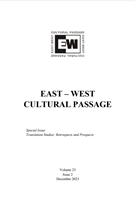Teaching Visually Impaired Translators and Interpreters in Romania: Available Tools and Inclusive Teaching Methods
Teaching Visually Impaired Translators and Interpreters in Romania: Available Tools and Inclusive Teaching Methods
Author(s): Alexandra MoldovanSubject(s): Higher Education , State/Government and Education, Translation Studies, Inclusive Education / Inclusion, Sociology of Education
Published by: Editura Universitatii LUCIAN BLAGA din Sibiu
Keywords: translation; interpreting; accessibility; assistivetechnology; digital skills; professional skills; superior education; professors; mixed groups; inclusion;
Summary/Abstract: This article explores the teaching methods used in university classes of Translation and Interpreting with visually impaired students. It is the first essay on this topic applied to the context of Romania. Therefore, it offers basic suggestions of implementing international teaching methods for visually impaired students in Translation and Interpreting in Romanian universities, while also raising awareness about the challenges they face. The literature review is divided into two categories: digital skills and professional skills. In presenting the most essential digital skills a visually impaired translator and interpreter must acquire, the article makes reference to Kornacki’s model which groups technologies according to the necessary skills. The professional skills are discussed in three articles from two different universities, namely the University of Trieste in Italy and the University of Mainz/Germersheim in Germany. The German study described in two articles – one in German and its shorter version in English – gives a detailed perspective on the topic, being the core of the theoretical ideas mentioned in this article. The knowledge acquired by reading this article will most certainly lead Romanian professors to using the optimal approach when teaching emerging visually impaired translators and interpreters. The teaching methods can be put into practice if the right equipment is available and accessibility is implemented in all aspects regarding translation and interpreting.
Journal: East-West Cultural Passage
- Issue Year: 23/2023
- Issue No: 2
- Page Range: 180-198
- Page Count: 19
- Language: English
- Content File-PDF

